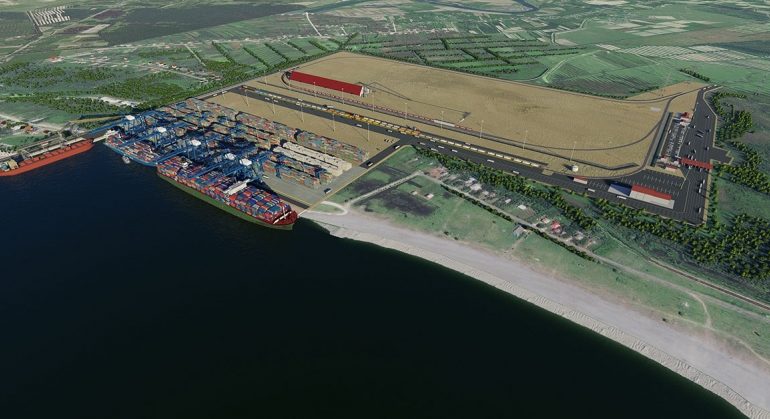What is one of the world’s largest dredging vessels doing in Georgia, a country that is several thousand miles from the nearest ocean and boasts some of Europe’s highest mountains? It is there because little Georgia, with a population of only 3.7 million, is constructing a major international deep sea port on its Black Sea coast. Anaklia, as the new port has been named, will be a game changer in just about every respect.
Anyone who has observed the huge ships in the Bosporus at Istanbul knows the problem Anaklia is designed to solve. An ocean-going freighter from the Americas or Africa can pass into the Mediterranean at Gibraltar or arrive from the Persian Gulf via Suez. All of these, as well as large ships from any port in Europe, can pass easily into the Black Sea. But if their cargo is headed to the East—Azerbaijan, Central Asia, China, Afghanistan or even Pakistan—there has not been any port on the eastern end of the Black Sea that can accommodate them.
The same problem existed for goods coming from the East. China has pushed hard to open a transport corridor across Central Asia to the Caspian Sea and beyond. But for now, most western-bound traffic heads north from Kazakhstan through Russia. New Caspian ports being built by Kazakhstan, Turkmenistan, and Azerbaijan will enable goods to go directly West by rail from Baku, Azerbaijan, to Georgia and on to Turkey. But the alternate sea route from Georgia to the rest of the world has been blocked by the absence of a deep-sea port. Such a port must accommodate ships with a draft of up to seventeen meters. That will be Anaklia.
Once functioning, Anaklia will be the only deep-sea port east of the Bosporus able to host “Panamax” vessels, i.e., those that can traverse the widened and deepened Panama Canal. Goods crossing from Anaklia can then proceed by ship into the Danube system, or by train to anywhere in Central or southern Europe. Or they can proceed directly to the Mediterranean and beyond.
Since 2017 hundreds of workers from the surrounding area have been hard at work constructing the new port. In the near future they will begin building Anaklia City, which is designed to be a free-trade zone and regional commercial center serving Georgia, Armenia, Azerbaijan, the Russian Caucasus, and northeastern Turkey. Because of the country’s central location, its sixth place ranking (out of 190 countries) in the World Bank’s “Ease of Doing Business” report, and to its having the second lowest perceived incidence of crime in Europe, according to the NUMBEO Crime Index, Georgians hope that firms from both Europe and Asia will find it convenient to base their Silk Road offices in the new city.,
Mention of the Silk Road reminds us that over the millennia the territory of Georgia and the Caucasus were integral parts of the great trade routes connecting Europe with both China and India. Archaeological finds from ancient sites close by Anaklia confirm this. More recently, many countries have eyed the route from the Caspian Sea through the Caucasus to the Black Sea as key elements of the emerging continent-spanning transport corridors.
Thus, barely a year after the collapse of the USSR, the European Union launched its TRASECA program (Transport Corridor Europe-Caucasus-Asia) in order to open the Caucasus and Central Asia to the West. Then Azerbaijan, Georgia, Turkey and western partners teamed up to build a new pipeline from the Caspian to the Mediterranean and then a new highway and railroad from the Baku clear through Georgia and Turkey to Istanbul and beyond.
Simultaneously, the newly independent countries of Central Asia lying to the east of the Caspian launched their own programs to build roads and railroads that would link with the emerging corridor through the Caucasus. To this end, Kazakhstan undertook a massive project to create transport infrastructure stretching from its border with China to the Caspian shore. In the same spirit, Turkmenistan planned and constructed both road and railroad links between its border with Afghanistan and its Caspian shore.
Topping off this massive multinational effort were the construction of no fewer than five entirely new ports on the Caspian Sea itself. Throughout the Soviet era the Caspian had served mainly as a north-south sea link between Iran and Russia. Thanks to these initiatives arising from both the Caucasus and Central Asia the Caspian has been transformed into a major corridor of east-west transport. To achieve this, the littoral countries—Azerbaijan, Kazakhstan, and Turkmenistan –have constructed modern new ports at Aylat, Aktau, and Turkmenbashi to serve what they expect to be the massive growth of east-west and west-east transport over the coming years. All three of these mega-projects will pour goods through Anaklia and will in turn serve as entrepots for goods being sent east from Anaklia.
How does China figure in this picture, and especially its Belt and Road Initiative (BRI)? Announced in 2013 by President Xi Jinping, BRI mapped out infrastructure projects that would be necessary in order to create a global transport network centering on China. Significantly, it also created a fund that could eventually reach hundreds of billions of dollars, to be parceled out mainly as loans to partner countries so as to enable them to pay for the construction of roads, railroads, and ports on their territory.
Notwithstanding the fact that all of the above projects appear on Chinese maps of the BRI network, they were—with one exception—funded entirely by the countries themselves and not by China. The exception was the road and railroad across Kazakhstan, which received partial funding from China beginning in the 1990s. For both countries this was a strategic decision. Kazakhstan saw these loans as the only way to open east-west transport across the country and to break Russia’s monopoly over its foreign trade, and China saw it as essential to preventing its trade with Europe from becoming totally dependent on Russia’s Trans-Siberian Railroad.
Meanwhile, the Government of Georgia moved quickly to expand its relations with China and to make sure that its Anaklia project would occupy a significant place on China’s global transport maps. It had already convened a “Silk Road Forum” in Tbilisi in 2015 and then in 2017 held a “Belt and Road Forum,” with strong representation from China. Georgia also bought twenty-eight Chinese freight locomotives and agreed to collaborate with China on developing both its energy network and agriculture. By that year China had become Georgia’s third largest trading partner, an increase of forty times since 2002, and had taken out loans from six different Chinese financial institutions.
These developments might tempt one to conclude that Georgia has been thoroughly drawn into China’s transport orbit and perhaps developed a dangerous financial dependency as well. This appears not to be the case. It is true that Chinese firms have invested in the free industrial zone at Poti, one of Georgia‘s two other Black Sea ports, but the sums involved are not large, and the U.S. is an active participant in the more important project, namely, upgrading Poti’s port. And it is also true that the Anaklia project is expected to receive up to $400 million in loans from the diversified pool of four European, American, and Asian financial institutions, with China’s new Asian Infrastructure Development Bank providing only 25% of the total. Further funding comes from the Government of Georgia and private Georgian investors.
Thus, the fact that Anaklia appears with a star on recent Chinese maps of BRI does not mean that China controls it either directly or indirectly, through debt. To their credit, the Georgians have worked out a constructive relationship to China and BRI, just as they have done with Europe and TRASECA. China has even broached further transport projects with Tbilisi. But Georgians are far too protective of their sovereignty to allow China to control them through debt.
From top to bottom Anaklia has a strong Atlanticist stamp. SSA Marine of Seattle, one of the world’s largest port managers, will run Anaklia’s terminal. Bob Watters, SSA Marine’s senior vice president, sees the growth of Anaklia’s cargo port as “very exciting.” Anaklia City’s judicial and mediation services are expected to operate on the basis of British law. German, Swiss, and Danish logistics giants are expected to dominate west-east shipping. Mamuka Khazaradze, a Georgian entrepreneur and banker who founded and presides over TBC Holding, the founding member of the Anaklia Development Consortium.
It is no secret that what was once the southern border of the Soviet Union is today one of the world’s major geopolitical fault-lines. Recent events in Ukraine and Crimea vividly remind us that that that line runs from the Black Sea straight through the South Caucasus, from Georgia to Azerbaijan. Inevitably, it involves not only the new ports at Anaklia and Aylat but their counterparts on the eastern shore of the Caspian as well: Kazakhstan’s Aktau and Turkmenistan’s Turkmenbashi. Georgians have not forgotten the Russian army’s invasion of their country in August 2008, nor can they ignore the pressure Moscow is exerting against Ukraine’s Black Sea ports at Kerch, Berdyansk, and Mariupol. However, for the time being Putin and his foreign minister, Sergei Lavrov, have kept their silence about Anaklia. To be sure, in an interview with Russian journalist D. Aslomov, Lavrov hinted that Russia would respond to any military activity in Anaklia, but he went no further. Perhaps he and Putin want to avoid further conflict with Europe and America or, more likely, are not prepared to oppose something favored by its nominal ally, China. Or perhaps they have concluded that the new port does Russia no harm and could even benefit its impoverished and conflicted provinces in the North Caucasus.
If Anaklia poses no direct threat to Russia, it will be a positive boon to Central and East European countries that were once under Moscow’s sway. For Poland, it mitigates the risk of depending on the unreliable Belarus-Russia border and the railroad line running south to Kazakhstan, which Russia could close at any time. Polish goods will be able to reach Anaklia through the Krakow-Constanza route or via Katowice and Odessa. Indeed, Polish producers are already looking to Anaklia as the gateway through which they can reach markets in Central Asia, China, the Middle East, and India. Similarly, Romania will benefit by being linked to the East through its major port of Constanza, while other Central European countries will gain similar access via the Rhine-Danube Corridor and its direct link to Constanza. Meanwhile, of course, Europe’s Mediterranean and North Seas ports will be able to send goods to the entire East through Anaklia. If this happens, Georgia’s new port will have enabled Poland to implement its centuries-old dream of connecting the Baltic and Black Seas.
At first glance Turkey might seem to pose a problem for Anaklia. Has it not invested heavily in the railroad connecting Baku and Istanbul by way of northeastern Anatolia? But Georgia has been a partner in that Baku-Tbilisi-Kars project from the beginning and sees the rail and sea links not as competitors but as complementary to one another. Moreover, Anaklia will give eastern Turkey’s agricultural hinterland ready access to a deep-sea port, whence foodstuffs can be sent to diverse markets on several continents. Much the same can be said of northern Iran. To be sure, the Iranians are working hard to complete a modern rail line from Turkey to its new Gulf of Oman port and free trade zone at Chabahar, currently under Indian management. This could eventually provide competition to the railroad running between Baku and Istanbul, although important impediments (of which sanctions are only one) would first have to be overcome. But if shippers from India wish to get their goods to northern Europe or North America, a far more efficient route than sending them by rail from Chabahar to Istanbul would be to trans-ship them directly to Anaklia via the railroad connection through Baku.
Finally, we should note the potential value of Anaklia to the countries of Central Asia. Uzbekistan, for example, is the world’s fourth largest producer of raw cotton, much of which it still markets through the distant Baltic ports, which they reach via the Russian railroad network. Both Tajikistan and Turkmenistan grow cotton as well, and share Uzbekistan’s difficulties in getting their crop to market. Anaklia could greatly speed this process and also cut costs. Other products of landlocked Central Asia could reach markets more efficiently by being shipped from the eastern Caspian ports of Aktau or Turkmenbashi to Aylat in Azerbaijan and thence by a short overland trip to Anaklia.
These scenarios are undeniably attractive and would seem to justify the cost and labor involved in creating a completely new port and commercial center. But are they the whole story? What are the pitfalls that might befall the Anaklia project and which of these have the potential to delay or even prevent its full development? A sober answer to this question must be included in any fair assessment of this $2.5 billion project.
A first factor that threatens to dim Anaklia’s luster is the sheer inefficiency of the TRASECA corridor to date. Over the entire decade since 2010 the transit of European goods through Georgia and Azerbaijan has steadily declined. Border crossings have often slowed to a snail’s pace and tariffs along the route have been volatile, even though signed agreements should have prevented this. Bluntly, the European Union’s vaunted TRASECA Corridor is by no means competitive today and shows few signs of becoming so in the immediate future. EU offices face more urgent tasks and many of the countries along the TRASECA route from western Europe to Georgia and Azerbaijan are preoccupied with what they consider more immediate problems. Of course, Anaklia itself will create pressure to improve this situation, but there is as yet no sign that the EU will initiate the process.
In the absence of a functioning deep-water port on Georgia’s Black Sea coast, and with the Caspian ports of Aktau and Aylat only now beginning to flourish, nearly all cargo from China has reached Europe by crossing Kazakhstan and then diverting northward to Russia’s Trans-Siberian Railroad, and thence to northern Germany. Anaklia, working in tandem with Aktau and Aylat, should attract a significant part of this Europe-bound trade to the Caucasus route, i.e., to the EU’s TRASECA. The exact extent of this shift will depend less on governments than the judgment of the market. At any rate, China itself seeks to make greater use of the Caucasus route and therefore has supported Anaklia.
A major long-term argument against the viability of Anaklia is that China’s productivity is bound to decline over the coming decades as its labor force shrinks and the number of its retirees soars. Demographic data confirm that this process has begun, and is unstoppable. This development will limit Chinese production and hence China-Europe trade. Tending towards the same outcome would be a greater emphasis on high-value-added goods, which may mean less bulk to be transported.
Meanwhile, the size of the labor force of the Indian sub-continent (India, Pakistan, and Bangla Desh) is soaring while the number of its retirees remains relatively small. With a labor force that will be twice the size of China’s within a generation, it is all but inevitable that the Indian sub-continent will become a world economic center, as indeed is already happening. This will generate great demand for east-west transport, which will be met by a combination of sea and land routes. The Great India Road, India’s counterpart to the Silk Road to China, is older and longer than the China route. Until it was cut by the Soviet borders, it also carried more goods and was less frequently interrupted than the Silk Road between China and Europe. This route went straight to the Caspian shores at Baku, Azerbaijan and thence to the Black Sea.
The revival of this long-forgotten Great India Road will more than make up for any long-term decline of Chinese shipping through Anaklia that might occur. Indeed, the first steps towards this revival are already being taken. Thus, Afghanistan and Turkmenistan are working to revive what they call the Lapis Lazuli Corridor from their common border clear to Europe via the Caucasus. And only recently Afghanistan, Pakistan, Kazakhstan, Uzbekistan, and Russia signed a deal to complete the rail connection across the width of Afghanistan to Peshawar in Pakistan. Meanwhile, two newly built ports on the Arabian Sea– Pakistan’s Gwadar and Iran‘s Chabahar– will enable goods shipped from the East to proceed westward by land, with the route through the Caucasus to Anaklia being a strong option.
There is no lack of hypothetical impediments to the future success of Anaklia. Among them, none is more compelling than the possibility of continued low international prices on oil. This would reduce the cost of shipping goods from China to Europe by sea and could therefore cut into the volume of land cargo from the East that should feed Anaklia. But that shift would at the same time benefit Anaklia by reducing shipping cost for the deep-sea vessels it will accommodate. In other words, like all the other potentially retarding factors discussed here, there are good reasons to think that this one may not prove significant, if it emerges at all.
On the other side of the ledger are the many potential benefits that Anaklia may bring. First, it will facilitate trade and interaction between Europe and China. China’s BRI has elicited a skeptical response from many in the West and many elsewhere as well. However, neither in the Caucasus nor in Central Asia are the declared interests of China, Europe and the United States in conflict. In fact, these are regions where one could imagine East and West working out practical understandings. If Anaklia could help bring that about, it will have been an agent of compromise in a situation otherwise defined by conflict.
Second, Anaklia–port and city–will be as the biggest development project ever undertaken in the western Caucasus. As such, it has the potential to impact positively on the entire region, including both Russia’s North Caucasus, Armenia, northern Iran, and the poorer regions of western Georgia itself. In light of the fact that these regions have been several times been riven by conflict since the collapse of the USSR, the economic and social development Anaklia fosters is bound to be beneficial.
Third, the benefits this new port and commercial center will bring to Georgia itself are notable. They will create thousands of jobs, most of them requiring modern skills and a significant number of them being in emerging sectors of technology and finance. This in turn will diversify Georgia’s economy and make it more self-sustaining, which in turn will render the society more modern and forward looking. Anaklia looks both east and west, but its strongest impact on Georgia will be to strengthen its ties with Europe and the Atlantic world. Georgians themselves have already declared integration with European life and culture to be their strategic objective. By offering European economies a new path by which their products can reach the East, it will strengthen Europe’s appreciation of Georgia, not just as an attractive if curious distant land but as a country that contributes directly to Europe’s own welfare.
These and many other considerations underscore the value and importance of Anaklia for the United States. True, it will bring profits and jobs to the port’s builder, Conti Group of New Jersey, and to SSA Marine of Seattle, which will oversee its operations. And by expanding the channels for continental trade across Eurasia, Anaklia (and the upgraded but smaller port at nearby Poti) will create opportunities for American manufacturers and their branches in Europe, and for American firms in such diverse areas as shipping, logistics, insurance, hotels, and storage. These important developments will all have a positive impact regionally, involving equally Azerbaijan and its new port at Aylat, and both Kazakhstan and Turkmenistan, with their new Caspian ports. Others who will benefit from the expanded corridor created by Anaklia will include Uzbekistan, Tajikistan and Afghanistan, all of which figure prominently among U.S. interests. Such developments will help both Washington and Brussels to define a new strategy towards the Caucasus and Central Asia, one that stresses continental trade through the region, and which is prepared to find common cause with other powers–including China, Russia, and India–so long as they respect the sovereignty and self-determination of both regions. In the end, Anaklia benefits all countries that seek a new order in the Caucasus and Central Asia based not on confrontation and interference but on trade and cooperation.
Anaklia is a fifty-two year project and it is only now beginning its second year. Many aspects of its future development have yet to be worked out, and its impact on the world around it for now remains hypothetical. What is already clear, however, is that Georgians are capable of conceiving, planning, and carrying out highly complex and significant projects that serve their country, their region, and the world. Not bad for a country of 3.75 million that is better known for its wine and tourism than for its contribution to continental commerce.
Source: European Interest.















